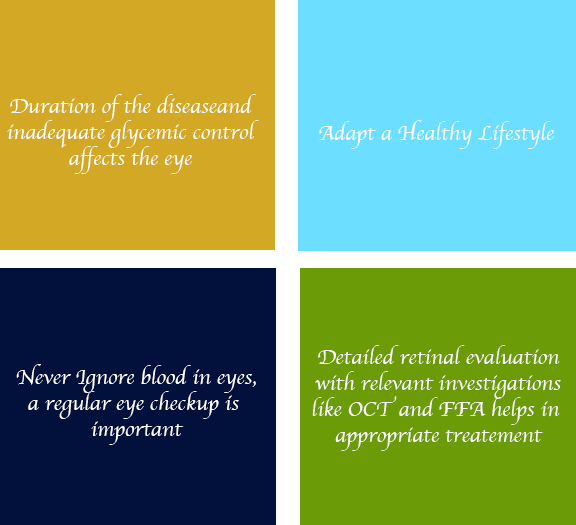Medical Retina (आँख का पर्दा)
In this service we treat conditions at the back of the eye, which are treated medically using drugs, eye drops or lasers, and includes diabetic eye screening. Conditions treated by clinicians in this service include age-related macular degeneration (AMD), retinitis pigmentosa, diabetic retinopathy, retinal blood vessel blockages and inflammation at the back of the eye (uveitis).
Ther are various kind of diseases falls under Medical Retina category which are as follows:
- Age-related macular degeneration (AMD)
- Diabetic Retinopathy
- Diabetic Macular Edema(DME)
What is Diabetic Retinopathy?
Diabetic retinopathy is a diabetes complication that affects eyes. It's caused by damage to the blood vessels of the light-sensitive tissue at the back of the eye (retina).
At first, diabetic retinopathy may cause no symptoms or only mild vision problems. Eventually, it can cause blindness.
The condition can develop in anyone who has type 1 or type 2 diabetes. The longer you have diabetes and the less controlled your blood sugar is, the more likely you are to develop this eye complication.
SYMPTOMS
You might not have symptoms in the early stages of diabetic retinopathy. As the condition progresses, diabetic retinopathy symptoms may include:
- Spots or dark strings floating in your vision (floaters)
- Blurred vision
- Fluctuating vision
- Impaired color vision
- Dark or empty areas in your vision
- Vision loss
Diabetic retinopathy usually affects both eyes.

What is the treatment?
Treatment, which depends largely on the type of diabetic retinopathy you have and how severe it is, is geared to slowing or delaying progression of the condition.
Early diabetic retinopathy
If you have mild or moderate nonproliferative diabetic retinopathy, you may not need treatment right away. However, your eye doctor will closely monitor your eyes to determine when you might need treatment. Investigations like OCT and FFA help in early diagnosis of the changes and thereby decreasing the effect of diabetes on the quality of vision.
Work with your diabetes doctor (endocrinologist) to determine if there are ways to improve your diabetes management. When diabetic retinopathy is mild or moderate, good blood sugar control can usually slow the progression.
We work with you to determine if there are ways to improve your diabetes management. When diabetic retinopathy is mild or moderate, good blood sugar control can usually slow the progression.
Advanced diabetic retinopathy
If you have proliferative diabetic retinopathy or macular edema, you'll need prompt surgical treatment. Depending on the specific problems with your retina, options may include:
- Photocoagulation: This laser treatment, also known as focal laser treatment, can stop or slow the leakage of blood and fluid in the eye. During the procedure, leaks from abnormal blood vessels are treated with laser burns.
- Panretinal photocoagulation: This laser treatment, also known as scatter laser treatment, can shrink the abnormal blood vessels. During the procedure, the areas of the retina away from the macula are treated with scattered laser burns. The burns cause the abnormal new blood vessels to shrink and scar.
- Vitrectomy: This procedure uses a tiny incision in your eye to remove blood from the middle of the eye (vitreous) as well as scar tissue that's tugging on the retina. It's done in a surgery center or hospital using local or general anesthesia.
- Injecting medicine into the eye: Your doctor may suggest injecting medication into the vitreous in the eye. These medications, called vascular endothelial growth factor (VEGF) inhibitors, may help stop growth of new blood vessels by blocking the effects of growth signals the body sends to generate new blood vessels.
